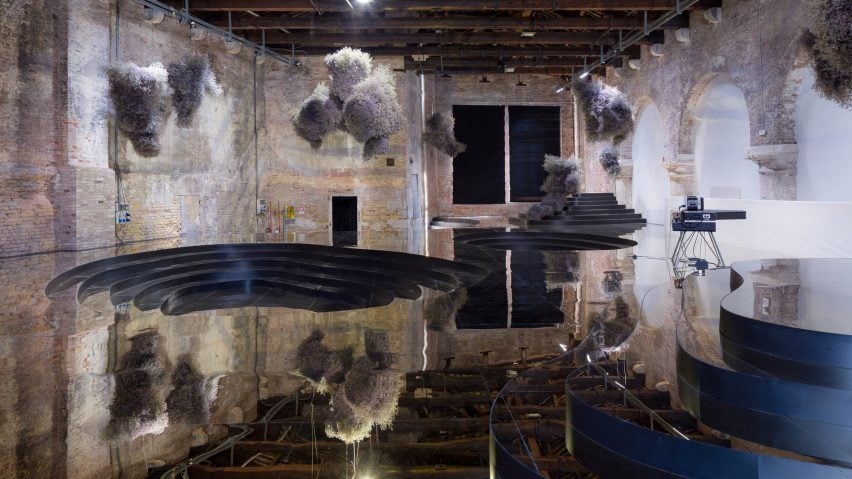Italian studio Space Caviar has constructed Dixit Algorizmi: The Garden of Knowledge, an indoor garden with reflective steel steps for the Uzbekistan pavilion at this year's Venice Art Biennale.
The installation at the Uzbekistan National Pavilion mirrors the interiors of the Quarta Tesa, an old shipbuilding warehouse at the Arsenale – one of the international contemporary art exhibition's two main sites.
The layout of the 500-square-metre garden is informed by the garden at the House of Wisdom, an academic centre in 9th-century Baghdad where medieval scholars, including the renowned Persian mathematician Muhammad al-Khwarizmi, studied.
Visitors at the 59th Venice Art Biennale can walk across the shiny floor of the installation and sit on glossy steps around what resemble traditional water basins.
"Gardens are very important in the tradition of Islam and the Arabic tradition in many parts of Central Asia," said Joseph Grima, co-founder of architectural research studio Space Caviar.
"While today we're accustomed to thinking of buildings and enclosed spaces such as research labs and universities as the space for the production of knowledge, in the days of al-Khwarizmi, gardens were typically the points of encounters, of discussion," Grima told Dezeen.
Space Caviar constructed the interiors of Uzbekistan's first pavilion at the Biennale in Venice from pine wood and sheets of stainless steel, which Grima chose to create the illusion of water.
The material choice also means that when the installation is dismantled at the end of the seven-month-long Biennale, the steel can be melted and turned back into metal sheets once again.
"Stainless steel was chosen to create the effect of walking on water — one of the perceptions that you have when you are inside the pavilion is that you are in a liquid landscape," Grima explained.
"This was one of the effects that we wanted to achieve with the pavilion, we wanted to create a landscape that was kind of a miracle, that suggested a dream more than a literal garden," he added.
"We see it as a technologically augmented landscape in that sense."
Throughout the Venice Art Biennale, the Uzbekistan pavilion will host a program of workshops and public events on the history of technological development in art with digital artists such as Andrés Reisinger.
Visitors will also be able to listen to Uzbek piano compositions against a backdrop of floral sculptures and hanging clouds of sea lavender by Berlin-based Studio Mary Lennox.
"We tried to transform our pavilion into an Islamic garden so that visitors could sit by the water, listen to various sounds, smell the air and enjoy the botanic installation," said Gayane Umerova, executive director of the art and culture development foundation under the Ministry of Culture of the Republic of Uzbekistan.
"The Islamic garden is a place of rest and reflection par excellence, it provides means for contemplation through sensory experience – aromas, plants, water," she told Dezeen.
"Undulating waters and ambiguous lines together with plants and smooth surfaces offer a meditative yet contemporary attitude to the interior of the pavilion, bringing together traditions and new technologies," she continued.
Genoa-based Space Caviar was founded by Joseph Grima and Tamar Shafrir in 2013. The studio focuses on the intersection between design, technology, critical theory and the public space.
Previous projects have included an algorithmic journalism machine that produces magazines on the fly and an exhibition at Biennale Interieur that explored how perspectives on the home have changed over time.
Last year Grima took part in the Dezeen 15 virtual festival, where he proposed a new type of non-extractive architecture that conserves the earth's resources.
Photography is by Gerda Studio.
Project credits:
Curation: Space Caviar and Sheida Ghomashchi
Commissioner: Gayane Umerova
Venice Art Biennale takes place from April 23 to November 27 in Venice. See Dezeen Events Guide for up-to-date details of architecture and design events around the world.

